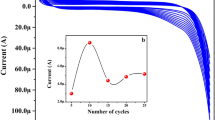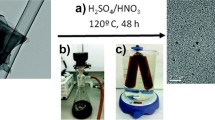Abstract
A chiral sensor is described for the enantioselective recognition of L- and D-tryptophan (Trp). The sensor is based on the use of (a) Cu(II) ions coordinated with β-cyclodextrin (Cu-β-CD) that was self-assembled with carboxymethyl cellulose (CD-Cu-CMC) as a chiral selector, (b) of N-doped reduced graphene oxide (N-rGO) as substrate materials, and (c) of differential pulse voltammetry that was used for enantiorecognition. The 3D N-rGO was prepared by using reduced graphene oxide and pyrrole as the starting materials. Electrostatic interaction occurs between the carboxy groups of CMC and Cu(II) ions in Cu-β-CD. The FT-IR, SEM, XRD and XPS techniques showed that 3D N-rGO and the CD-Cu-CMC composite were successfully synthesized. The 3D N-rGO enabled the immobilization of the chiral selector (CD-Cu-CMC) and improves the active areas. A glassy carbon electrode was modified with N-rGO/CD-Cu-CMC and then showed a stronger electrochemical signal for L-Trp than for D-Trp, typically at a working potential of around 0.78 V (vs. SCE). UV-vis spectroscopy proved that CD-Cu-CMC has a higher affinity for D-Trp. The enantioselectivity for D-Trp over L-Trp is 4.72. The modified electrode had a limit of detection of 0.063 μM and 0.0035 μM for L-Trp and D-Trp, respectively, with a linear response range of 0.01 mM to 5 mM. The sensor was used to detect Trp (D- or L-Trp) in spiked real human urine and human serum protein samples.

Schematic representation of an electrochemical chirality sensor based on the merits of N-rGO and CD-Cu-CMC. It involves the preparation of a chiral selector and a substrate material. N-Doped graphene oxide (N-rGO) was prepared by using graphene oxide (GO) and pyrrole as precursor. The combination of carboxymethyl cellulose (CMC) with Cu-β-CD leads to a novel self-assembly framework.






Similar content being viewed by others
References
Noguchi T, Roy B, Yoshihara D, Sakamoto J, Yamamoto T, Shinkai S (2017) A chiral recognition system orchestrated by self-assembly: molecular chirality, self-assembly morphology, and fluorescence response. Angew Chem Int Edit 56:12518–12522
Talele HR, Koval D, Severa L, Reyes-Gutiérrez PE, Císařová I, Sazelova P, Teplý F (2018) Diquats with robust chirality: facile resolution, synthesis of chiral dyes, and application as selectors in chiral analysis. Chem Eur J 24:7601–7604
Ibanez JG, Rincón ME, Gutierrez-Granados S, Chahma MH, Jaramillo-Quintero OA, Frontana-Uribe BA (2018) Conducting polymers in the fields of energy, environmental remediation, and chemical-chiral sensors. Chem Rev 118:4731–4816
Bo G, Gall MA, Kuschel S, Winter J, Gerbaux P, Leigh DA (2018) An artificial molecular machine that builds an asymmetric catalyst. Nat Nanotechnol 13:381
Han X, Huang J, Yuan C, Liu Y, Cui Y (2018) Chiral 3D covalent organic frameworks for high performance liquid chromatographic enantioseparation. J Am Chem Soc 140:892–895
Song G, Xu C, Li B (2015) Visual chiral recognition of mandelic acid enantiomers with L-tartaric acid-capped gold nanoparticles as colorimetric probes. Sensor Actuat B 215:504–509
Wang C, Wu X, Pu L (2017) A highly fluorinated chiral aldehyde for enantioselective fluorescent recognition in a biphasic system. Chem Eur J 23:10749–10752
Saz JM, Marina ML (2016) Recent advances on the use of cyclodextrins in the chiral analysis of drugs by capillary electrophoresis. J Chromatogr A 1467:79–94
Tao Y, Chu F, Gu X, Kong Y, Lv Y, Deng L (2018) A novel electrochemical chiral sensor for tyrosine isomers based on a coordination-driven self-assembly. Sensor Actuat B 255:255–261
Niu X, Mo Z, Yang X, Shuai C, Liu N, Guo R (2019) Graphene-ferrocene functionalized cyclodextrin composite with high electrochemical recognition capability for phenylalanine enantiomers. Bioelectrochemistry 128:74–82
Zhang Y, Liu G, Yao X, Gao S, Xie J, Xu H, Lin N (2018) Electrochemical chiral sensor based on cellulose nanocrystals and multiwall carbon nanotubes for discrimination of tryptophan enantiomers. Cellulose 25:3861–3871
Wu D, Tan W, Yu Y, Yang B, Li H, Kong Y (2018) A facile avenue to prepare chiral graphene sheets as electrode modification for electrochemical enantiorecognition. Anal Chim Acta 1033:58–64
Gou H, He J, Mo Z, Wei X, Hu R, Wang Y, Guo R (2016) A highly effective electrochemical chiral sensor of tryptophan enantiomers based on covalently functionalize reduced graphene oxide with L-lysine. J Electrochem Soc 163:B272–B279
Bao L, Chen X, Yang B, Tao Y, Kong Y (2016) Construction of electrochemical chiral interfaces with integrated polysaccharides via amidation. ACS Appl Mater Inter 8:21710–21720
Bao L, Dai J, Yang L, Ma J, Tao Y, Deng L, Kong Y (2015) Electrochemical recognition of tyrosine enantiomers based on chiral ligand exchange with sodium alginate as the chiral selector. J Electrochem Soc 162:H486–H491
Lei P, Zhou Y, Zhang G, Zhang Y, Zhang C, Hong S, Shuang S (2019) A highly efficient chiral sensing platform for tryptophan isomers based on a coordination self-assembly. Talanta 195:306–312
Tao Y, Gu X, Deng L, Qin Y, Xue H, Kong Y (2015) Chiral recognition of D-tryptophan by confining high-energy water molecules inside the cavity of copper-modified β-cyclodextrin. J Phys Chem C 119:8183–8190
Tao Y, Dai J, Kong Y, Sha Y (2014) Temperature-sensitive electrochemical recognition of tryptophan enantiomers based on β-cyclodextrin self-assembled on poly (L-glutamic acid). Anal Chem 86:2633–2639
Niu X, Yang X, Mo Z, Guo R, Liu N, Zhao P, Ouyang M (2019) Voltammetric enantiomeric differentiation of tryptophan by using multiwalled carbon nanotubes functionalized with ferrocene and β-cyclodextrin. Electrochim Acta 297:650–659
Ma X, Xie Y, Yu Y, Lu L, Liu G, Yu Y, Hu C (2018) Three-dimensional β-cyclodextrin functionalized graphene aerogels: an enhanced electrochemical sensing platform for quantification of Ponceau 4R. J Electroanal Chem 823:437–444
Jia H, Xu J, Lu L, Yu Y, Zuo Y, Tian Q, Li P (2018) Three-dimensional au nanoparticles/nano-poly (3, 4-ethylene dioxythiophene)-graphene aerogel nanocomposite: a high-performance electrochemical immunosensing platform for prostate specific antigen detection. Sensor Actuat B 260:990–997
Kannappan S, Yang H, Kaliyappan K, Manian RK, Pandian AS, Lee YS, Lu W (2018) Thiolated-graphene-based supercapacitors with high energy density and stable cycling performance. Carbon 134:326–333
Jeon IY, Ju MJ, Xu J, Choi HJ, Seo JM, Kim MJ, Liu HK (2015) Edge-fluorinated graphene Nanoplatelets as high performance electrodes for dye-sensitized solar cells and Lithium ion batteries. Adv Funct Mater 25:1170–1179
Park CS, Yoon H, Kwon OS (2016) Graphene-based nanoelectronic biosensors. J Ind Eng Chem 38:13–22
Fu K, Wang Y, Yan C, Yao Y, Chen Y, Dai J, Wang Z (2016) Graphene oxide-based electrode inks for 3D-printed lithium-ion batteries. Adv Mater 28:2587–2594
Xie Y, Tu X, Ma X, Fang Q, Lu L, Yu Y, Liu C (2019) High-performance voltammetric sensor for dichlorophenol based on β-cyclodextrin functionalized boron-doped graphene composite aerogels. Nanotechnology 30:18
Yang W, Zhou M, Oturan N, Li Y, Su P, Oturan MA (2019) Enhanced activation of hydrogen peroxide using nitrogen doped graphene for effective removal of herbicide 2, 4-D from water by iron-free electrochemical advanced oxidation. Electrochim Acta 297:582–592
Wu K, Yang H, Jia L, Pan Y, Hao Y, Zhang K, Hu G (2019) Smart construction of 3D N-doped graphene honeycombs with (NH4)2SO4 as a multifunctional template for Li-ion battery anode: “a choice that serves three purposes”. Green Chem 21:1472–1483
Yuan R, Yuan J, Wu Y, Ju P, Ji L, Li H, Chen J (2018) Graphene oxide-monohydrated manganese phosphate composites: preparation via modified hummers method. Colloid Surface A 547:56–63
Matsui Y, Kurita T, Date Y (1972) Complexes of copper (II) with cyclodextrins. B Chem Soc Jap 45:3229–3229
Chen S, Duan J, Jaroniec M, Qiao SZ (2013) Three-dimensional N-doped graphene hydrogel/NiCo double hydroxide electrocatalysts for highly efficient oxygen evolution. Angew Chem Int Edit 125:13812–13815
Wang YG, Li HQ, Xia YY (2006) Ordered whiskerlike polyaniline grown on the surface of mesoporous carbon and its electrochemical capacitance performance. Adv Mater 18:2619–2623
Liang W, Rong Y, Fan L, Dong W, Dong Q, Yang C, Wong WY (2018) 3D graphene/hydroxypropyl-β-cyclodextrin nanocomposite as an electrochemical chiral sensor for the recognition of tryptophan enantiomers. J Mater Chem C 6:12822–12829
Gu X, Tao Y, Pan Y, Deng L, Bao L, Kong Y (2015) DNA-inspired electrochemical recognition of tryptophan isomers by electrodeposited chitosan and sulfonated chitosan. Anal Chem 87:9481–9486
Benesi HA, Hildebrand JHJ (1949) A spectrophotometric investigation of the interaction of iodine with aromatic hydrocarbons. J Am Chem Soc 71:2703–2707
Acknowledgements
This work was funded by the National Natural Science Foundation of China (51262027), the State Key Laboratory of Solidification Processing in NWPU (SKLSP201754), the Science and Technology Project Gansu Province (17YF1GA017), the Research Project of Higher Education in Gansu Province (2017A-002), and the Science and Technology Project Gansu Province (17JR5RA082).
Author information
Authors and Affiliations
Corresponding author
Ethics declarations
The author(s) declare that they have no competing interests.
Additional information
Publisher’s note
Springer Nature remains neutral with regard to jurisdictional claims in published maps and institutional affiliations.
Electronic supplementary material
ESM 1
(DOCX 2165 kb)
Rights and permissions
About this article
Cite this article
Niu, X., Yang, X., Mo, Z. et al. Electrochemical chiral sensing of tryptophan enantiomers by using 3D nitrogen-doped reduced graphene oxide and self-assembled polysaccharides. Microchim Acta 186, 557 (2019). https://doi.org/10.1007/s00604-019-3682-4
Received:
Accepted:
Published:
DOI: https://doi.org/10.1007/s00604-019-3682-4




